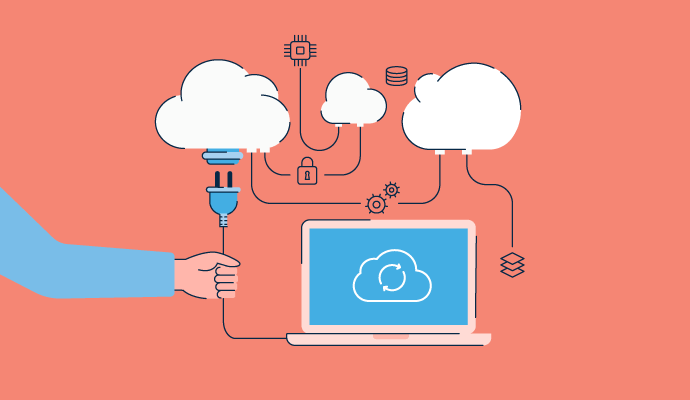What is Cloud?
In the context of computing, the term “cloud” refers to a network of remote servers that are hosted on the internet and used to store, manage, and process data. These servers are typically owned and operated by a third-party provider, who offers various services and resources over the internet.
Cloud computing allows users to access and utilize computing resources, such as virtual machines, storage, databases, software applications, and other services, without having to maintain their own physical infrastructure. Instead of running software or storing data on local computers or servers, individuals and organizations can leverage the power and scalability of cloud resources.
The cloud offers several advantages, including:
- Scalability: Cloud services can easily scale up or down based on the needs of the user. Resources can be rapidly provisioned or de-provisioned, allowing for flexibility and cost optimization.
- Accessibility: Cloud services can be accessed from anywhere with an internet connection, enabling users to work and access their data from different devices and locations.
- Cost-effectiveness: Cloud computing follows a pay-as-you-go model, where users only pay for the resources they consume. This eliminates the need for significant upfront investments in hardware and infrastructure.
- Reliability and Availability: Cloud providers typically offer robust infrastructure with built-in redundancy and failover mechanisms, ensuring high availability of services and minimizing the risk of data loss.
- Collaboration and Sharing: Cloud services facilitate collaboration by allowing multiple users to access, share, and work on the same data or applications simultaneously.
Examples of cloud services include cloud storage platforms like Dropbox and Google Drive, cloud-based productivity suites like Google Workspace and Microsoft Office 365, cloud-based databases like Amazon RDS and Microsoft Azure SQL Database, and cloud computing platforms like Amazon Web Services (AWS), Microsoft Azure, and Google Cloud Platform (GCP).
Overall, the cloud provides a flexible and convenient way to store and access data, run applications, and leverage computing resources without the need for extensive local infrastructure.
When should a business consider moving to cloud?
A business may consider moving to the cloud under various circumstances. Here are some scenarios that often prompt businesses to make the transition:
- Scalability and Flexibility Needs: If a business experiences fluctuating demands for computing resources, such as storage, processing power, or bandwidth, the cloud can provide scalability. Cloud services allow businesses to easily scale up or down their resources based on demand, providing flexibility and cost optimization.
- Cost Reduction: The cloud can offer cost savings for businesses by eliminating the need for upfront investments in hardware, software licenses, and infrastructure maintenance. Instead, businesses can opt for a pay-as-you-go model, paying only for the resources they consume. Additionally, the cloud reduces costs associated with managing and maintaining on-premises data centers.
- Geographic Expansion: When a business expands its operations to multiple locations or enters global markets, the cloud provides a scalable and accessible infrastructure to support these expansions. Cloud services enable businesses to quickly provision resources in different regions, ensuring reliable and efficient operations across geographic boundaries.
- Data Backup and Disaster Recovery: The cloud offers reliable data backup and disaster recovery solutions. Storing data in the cloud ensures that it is protected against hardware failures, natural disasters, or other disruptions. Cloud providers often have built-in data redundancy and disaster recovery mechanisms, ensuring high availability and minimal data loss.
- Collaboration and Remote Work: In today’s digital workplace, where remote work and collaboration are increasingly common, the cloud provides a centralized platform for employees to access and collaborate on data and applications from anywhere with an internet connection. Cloud-based productivity tools and collaboration suites enable seamless teamwork and information sharing.
- Enhanced Security: Cloud providers often have robust security measures in place to protect data and infrastructure. They employ advanced security technologies, encryption, and access controls to safeguard business information. For some businesses, migrating to the cloud can improve their security posture compared to managing their own on-premises infrastructure.
- Agility and Innovation: The cloud enables businesses to quickly adopt new technologies and innovate. Cloud services offer a wide range of tools, APIs, and integrations that allow businesses to experiment, develop, and deploy applications rapidly. This agility can give businesses a competitive advantage in today’s fast-paced digital landscape.
It’s important for businesses to carefully assess their specific needs, goals, and requirements before deciding to move to the cloud. Conducting a cost-benefit analysis and evaluating the potential impact on operations, security, compliance, and existing infrastructure are crucial steps in the decision-making process.
What are some top cloud platforms?
There are several top cloud platforms available today, each offering a range of services and capabilities. Here are some of the leading cloud platforms:
- Amazon Web Services (AWS): AWS is the largest and most comprehensive cloud platform, offering a wide array of services, including compute power, storage, databases, networking, analytics, artificial intelligence (AI), machine learning (ML), Internet of Things (IoT), and more. AWS provides scalability, high availability, and global reach, making it a popular choice for businesses of all sizes.
- Microsoft Azure: Azure is a cloud computing platform provided by Microsoft. It offers a broad set of services for building, deploying, and managing applications and services through Microsoft-managed data centers. Azure supports various programming languages, tools, and frameworks and provides capabilities for virtual machines, databases, AI, ML, analytics, and IoT.
- Google Cloud Platform (GCP): GCP is a suite of cloud computing services offered by Google. It provides infrastructure as a service (IaaS), platform as a service (PaaS), and software as a service (SaaS) offerings. GCP includes services for compute, storage, networking, data analytics, AI, ML, and more. GCP focuses on data-intensive and AI-driven workloads and provides tight integration with other Google services.
- IBM Cloud: IBM Cloud is a platform that combines IaaS, PaaS, and SaaS services. It offers a range of tools and services for developing, running, and managing applications, including virtual machines, containers, serverless computing, data analytics, AI, and blockchain solutions. IBM Cloud also emphasizes enterprise-grade security and compliance.
- Oracle Cloud Infrastructure (OCI): OCI is Oracle’s cloud computing platform, providing a comprehensive set of IaaS, PaaS, and SaaS services. It offers capabilities for running and managing workloads, including computing, storage, networking, databases, AI, ML, and analytics. OCI focuses on supporting enterprise workloads, hybrid cloud environments, and optimizing performance.
- Alibaba Cloud: Alibaba Cloud is the cloud computing division of Alibaba Group, one of the largest e-commerce companies in the world. It provides a range of cloud services, including computing, storage, networking, databases, security, AI, ML, and big data analytics. Alibaba Cloud focuses on serving businesses in China and the Asia-Pacific region but also has a global presence.
These are just a few examples of the top cloud platforms available. Other notable players in the market include Salesforce’s Salesforce Platform, VMware’s VMware Cloud, and DigitalOcean’s cloud platform. The choice of a cloud platform depends on factors such as specific business requirements, the desired services and capabilities, geographic reach, pricing, and integration with existing systems and tools.


Leave a Reply